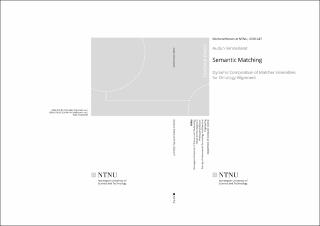| dc.contributor.advisor | Aalberg, Trond | |
| dc.contributor.advisor | Ramampiaro, Heri | |
| dc.contributor.advisor | Gulla, Jon Atle | |
| dc.contributor.author | Vennesland, Audun | |
| dc.date.accessioned | 2020-08-26T09:45:44Z | |
| dc.date.available | 2020-08-26T09:45:44Z | |
| dc.date.issued | 2020 | |
| dc.identifier.isbn | 978-82-326-4843-6 | |
| dc.identifier.issn | 1503-8181 | |
| dc.identifier.uri | https://hdl.handle.net/11250/2674337 | |
| dc.description.abstract | Semantic matching is a computational process that aims to automatically identify the semantic relationship between elements represented in different graph-like sources. Typically, this is a process that involves human decision making when it comes to selecting appropriate matching algorithms, configuring their similarity thresholds, and aggregating their results into a final alignment. This thesis proposes a more autonomous approach where such decisions are automatically determined by an analysis of terminological, structural and lexical features extracted from the ontologies to be matched.
A design science-centred research approach has guided the development. In several build-and-evaluate loops, matching artefacts have been developed and evaluated, iteratively improving the artefacts themselves as well as extracting lessons learned that extend current knowledge. The produced artefacts encompass ontology proling metrics that capture relevant features of the ontologies to be matched, matching algorithms that automatically compute an alignment holding equivalence and subsumption relations between concepts of two input ontologies, an alignment combination method that optimally combines the results from the ensemble of algorithms, and mismatch detection techniques that filter out false positive relations caused by ontology mismatches or heterogeneities. These individual artefacts are finally combined into a prototype semantic matching system.
The individual matching artefacts as well as the prototype system have been evaluated in three diverse datasets. In general, the evaluation results show that the proposed approach improves the quality of individual alignments as well as the combined alignment. Furthermore, the results confirm that some of the new ideas implemented in the matching algorithms contribute to the identification of \challenging" relations and that the suggested mismatch detection techniques can increase alignment precision. | en_US |
| dc.language.iso | eng | en_US |
| dc.publisher | NTNU | en_US |
| dc.relation.ispartofseries | Doctoral theses at NTNU;2020:247 | |
| dc.subject | SemanticMatching, Ontology Matching, Semantic Interoperability, Semantic Web, Data Integration, Ontology Engineering | en_US |
| dc.title | Semantic Matching: Dynamic Composition of Matcher Ensembles for Ontology Alignment | en_US |
| dc.type | Doctoral thesis | en_US |
| dc.subject.nsi | VDP::Technology: 500::Information and communication technology: 550::Computer technology: 551 | en_US |
